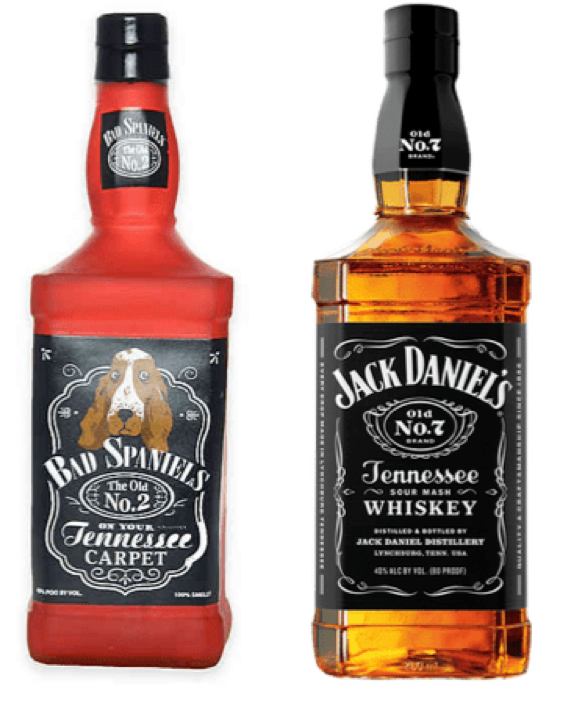“Crucially, under the Rogers approach, balancing of free speech and trademark considerations is only needed when the allegedly infringing or dilutive work is artistic. When it’s an ordinary commercial good, the usual principles of trademark law control.”
Editor’s Note: The authors co-authored an amicus brief for the International Trademark Association in the case discussed.
 Sometimes a dog toy is just a dog toy. Maybe that’s how Sigmund Freud would have put it; certainly, that’s the message from our client, the International Trademark Association (INTA), to the U.S. Supreme Court. At issue is a Ninth Circuit decision that extends First Amendment protection to ordinary commercial goods like dog toys, at the expense of trademark rights. INTA, Jack Daniel’s competitors, alcohol beverage industry associations, and other trademark advocates this week asked SCOTUS to step in and reverse.
Sometimes a dog toy is just a dog toy. Maybe that’s how Sigmund Freud would have put it; certainly, that’s the message from our client, the International Trademark Association (INTA), to the U.S. Supreme Court. At issue is a Ninth Circuit decision that extends First Amendment protection to ordinary commercial goods like dog toys, at the expense of trademark rights. INTA, Jack Daniel’s competitors, alcohol beverage industry associations, and other trademark advocates this week asked SCOTUS to step in and reverse.
As we reported in April, the Ninth Circuit held that a squeaking dog toy resembling the iconic Jack Daniel’s whiskey bottle is an expressive work entitled to First Amendment protection. VIP Prods. LLC v. Jack Daniel’s Properties, Inc., 953 F.3d 1170 (9th Cir. 2020). At the time, we urged Jack Daniel’s to seek certiorari; last month, it did so.
Trademark Law – Not the First Amendment – Controls Toys
The “Bad Spaniels Silly Squeaker” at issue replaces “Jack Daniel’s” with “Bad Spaniels.” It also replaces “Old No. 7 Tennessee Sour Mash Whiskey” with “Old No. 2 on your Tennessee Carpet,” and it replaces “40% ALC BY VOL (80 PROOF)” with “43% POO BY VOL” and “100% SMELLY.” The toy openly evokes the iconic Jack Daniel’s trade dress – but does it infringe and dilute, as Jack Daniel’s argued in its lawsuit?
The district court held (correctly, in INTA’s view) that the toy was not an expressive work, and therefore not entitled to First Amendment protection. The court held there was no need to balance free speech interests against trademark interests. Rather, whether the toy was infringing or diluting should be decided by applying traditional trademark law principles.
This approach followed the time-honored test first articulated in Rogers v. Grimaldi, 875 F.2d 994 (2d Cir. 1989). Under that test, in order to prevail on a claim of trademark infringement against an artistic work, a plaintiff must show that the defendant’s use of the mark either (1) is not artistically relevant to the underlying work or (2) explicitly misleads consumers as to the source or content of the work. Many other circuits now follow Rogers.
Crucially, under the Rogers approach, balancing of free speech and trademark considerations is only needed when the allegedly infringing or dilutive work is artistic. When it’s an ordinary commercial good, the usual principles of trademark law control. A trademark challenge to a song, book, or movie thus calls for First Amendment balancing; a trademark challenge to a toy, not so much.
A Misguided Reversal
The Ninth Circuit saw things differently. It said on appeal that the dog toy conveyed a “humorous message”; was therefore an expressive work; and should be judged under Rogers. The Ninth Circuit also reversed the district court’s finding of dilution by tarnishment – holding that because the toy was an expressive work, it fell under the “noncommercial use” exception of the Trademark Dilution Revision Act (TDRA).
In seeking certiorari, Jack Daniel’s argued that the Ninth Circuit’s decision was “egregiously misguided.” The Lanham Act’s likelihood-of-confusion test and the parody defense under the TDRA already take free speech interests into account – enough, certainly, to deal with what the Jack Daniel’s petition called “poop humor.” Jack Daniel’s thus argued for the traditional artistic-works limitation on Rogers, and for a comparably narrow reading of the TDRA’s “noncommercial use” exclusion.
Amici Step In
This week, INTA weighed in as amicus via a brief Debevoise co-authored as counsel of record:
- INTA stayed neutral on whether the Bad Spaniels toy is infringing or diluting—that is a question of fact that should be decided by the trial court (and was in fact decided by the trial court in this case).
- INTA joined Jack Daniel’s in arguing that the Ninth Circuit applied the wrong analytical framework: The Ninth Circuit’s decision “creates a sharp circuit split on how to balance competing claims of trademark protection and free speech in the context of claimed parodies embodied in commercial products as contrasted with artistic works.”
- INTA highlighted the many cases from other circuits that have either analyzed commercial products purporting to be parody under a trademark likelihood-of-confusion analysis, rather than a First Amendment analysis, or have limited the application of Rogers to artistic works.
- In contrast, the Ninth Circuit’s approach “is far out of step” with the other circuits and is an “outlier that threatens to undermine longstanding likelihood of confusion analysis for any product that arguably includes some expression of any kind.”
- With respect to dilution, INTA argued that the Ninth Circuit ignored the test that the Supreme Court established decades ago for analyzing commercial speech in Bolger v. Youngs Drug Prods. Corp., 463 U.S. 60 (1983).
INTA was hardly alone in decrying the Ninth Circuit’s decision. Other leaders in the trademark and alcohol beverage world also contributed various arguments that, taken together, make a strong case for granting certiorari:
Amicus Brief of Alcohol Beverage Industry
In light of the “extensive resources in combatting irresponsible alcohol use” invested by the alcohol beverage industry, six alcoholic beverage industry associations submitted a brief urging the Court to grant certiorari to ensure that industry participants do not lose control over their trademarks. The brief powerfully argued that, if infringing uses of famous marks (like the Bad Spaniels toy here) are granted exemptions from the Lanham Act, “then rampant infringement will make leading producers’ social responsibility meaningless by allowing parties outside of the industry’s self-regulatory system to use trademarks and trade dress associated with the industry to promote irresponsible drinking.” The brief described the industry’s extensive efforts towards self-regulation and responsible advertising, and argued that the Ninth Circuit’s decision undermines those efforts by “deal[ing] a serious blow to industry self-regulation and the well-established rights of trademark owners.”
The Ninth Circuit’s decision “opens the door” to use of members’ marks, for example, to sell T-shirts featuring a famous tequila brand in a joke about blacking out, or a bumper sticker using a well-known beer brand to announce the driver’s skill at driving drunk, so long as the infringer can claim that use of the marks furthers the humor of the products. One particular concern of the associations is that, under the Ninth Circuit’s ruling, would-be infringers could use others’ marks in humorous ways (such as on toys and games) and create a public perception that the alcohol industry accepts associations between its products and children, when it actually takes great efforts to avoid such an association. The brief urged the Court to grant certiorari to “clarify that claims of humor do not immunize flagrant violations of the Lanham Act.”
Amicus Brief of Constellation Brands
Constellation Brands’ portfolio includes many beers, wines and spirits such as Corona, Kim Crawford, and Svedka Vodka. Its brief gave examples of the type of authorized licensing that is appropriate for beers, wines and spirits, and of the type of inappropriate uses it has faced on commercial products in the name of parody. Constellation argued that the Court should grant certiorari to “restore the proper interpretation of the Lanham Act before meticulous investments by trademark owners like Constellation are further undermined.” Constellation expends significant time, money, and care (like many other brand owners) to “intentionally craft[ ] its brand images to ensure that each brand targets identified consumer interests.” The Ninth Circuit’s decision, according to Constellation, “has no basis in law” and allows opportunists to “pirate” other brands under the guise of humor, “no matter how severely it undermines consumer goodwill, brand value, or corporate reputation.” Similar to Jack Daniel’s and INTA, Constellation argued that the commercial speech doctrine and the Lanham Act fully resolve the issues in this case, without reference to the First Amendment.
Amicus Brief of Campbell Soup Company
Campbell Soup Company filed a brief to stress the importance of the issues in this case, and argued that “the Ninth Circuit blew gaping holes in the protections in the Lanham Act and the TDRA for mark owners and consumers.” Campbell Soup provided recent real-world examples of infringing activities beyond beers, wines and spirits that would receive unwarranted First Amendment protection under the Ninth Circuit’s framework simply due to the use of humor. Earlier this summer, for example, Campbell Soup stopped a third-party’s sale of T-shirts depicting a red and white Campbell’s soup label but adding the words “Bat Soup” and “Now With COVID-19.” “[D]espite their apparent attempt to make light of the ongoing global pandemic, [the T-shirts] clearly infringed and tarnished the reputation of Campbell’s Soup’s marks.” The Ninth Circuit’s decision “will encourage a proliferation of purportedly humorous commercial products”—like these T-shirts—that can harm a brand’s “carefully cultivated image.”
Amicus Brief of Campari America LLC
Campari agreed with the brief of the Alcohol Beverage Industry (in which it participated through its trade associations), and wrote separately to “highlight a particularly problematic aspect of the Ninth Circuit’s decision—namely, the conclusion that junior users (i.e., infringers) categorically have greater First Amendment rights than senior users (i.e., trademark holders) of a mark.” Campari argued that trademarks—such as MAKE AMERICA GREAT AGAIN, STAND UP TO CANCER, and TEXANS FOR ISRAEL—contain some expressive value beyond simply identifying the source of goods or services. Campari criticized Rogers for failing to show any “special solicitude for the free expression rights of trademark holders [and] [i]nstead it proceeds from the mistaken belief that only infringing uses implicate First Amendment principles.” Like other amici, Campari urged the Court to grant certiorari and hold that “the traditional likelihood-of-confusion balancing test under the Lanham Act is more than adequate to address and protect the rights of both the senior user and the junior user.”
Amicus Brief of Intellectual Property Law Association of Chicago (IPLAC)
Similar to Jack Daniel’s and INTA, the IPLAC argued that the Court should hear the case in order to resolve the circuit split concerning the legal standard that applies to infringement claims against humorous commercial products: “A mark or trade dress used in conjunction with the sale of a commercial product, even one that purports to be funny, should be subject to the same likelihood of confusion analysis for trademark infringement under the Lanham Act.” Like Jack Daniel’s and INTA, the IPLAC also argued that the simple use of humor does not render a commercial product “noncommercial” under the TDRA, and pointed out the risk of forum shopping based on the Ninth Circuit’s divergence from established law in the other circuits.
Respondent’s brief, if it chooses to respond, is due November 18. We will be monitoring activity as it develops.

![[IPWatchdog Logo]](https://ipwatchdog.com/wp-content/themes/IPWatchdog%20-%202023/assets/images/temp/logo-small@2x.png)


![[Advertisement]](https://ipwatchdog.com/wp-content/uploads/2024/04/Patent-Litigation-Masters-2024-sidebar-early-bird-ends-Apr-21-last-chance-700x500-1.jpg)

![[Advertisement]](https://ipwatchdog.com/wp-content/uploads/2021/12/WEBINAR-336-x-280-px.png)
![[Advertisement]](https://ipwatchdog.com/wp-content/uploads/2021/12/2021-Patent-Practice-on-Demand-recorded-Feb-2021-336-x-280.jpg)
![[Advertisement]](https://ipwatchdog.com/wp-content/uploads/2021/12/Ad-4-The-Invent-Patent-System™.png)







Join the Discussion
4 comments so far.
TFCFM
October 26, 2020 10:57 amBM: “This mock Jack Daniels bottle dog toy does seem to satisfy the satire doctrine…”
Thank you — you and the court put into words what I was unable to better express:
– NOBODY thinks the dog toy was produced by the same source as No Sense Of Humor Whiskey (i.e., no “confusion”).
– NOBODY thinks that the dog toy is a serious statement as to the characteristics of the registrant or the registrant’s particular products (i.e., no “tarnishment” or “dilution”).
Barney Molldrem`
October 23, 2020 10:20 amThis calls to mind other cases involving dog toys, especially Louis Vuitton v. Haute Diggety Dog, 507 F.3d 252 (4th Cir 2007), that ruled that a Chewy Vuitton dog chew toy that was intended to resemble the famous and pricey Louis Vuitton purse did not infringe or tarnish Louis Vuitton’s trademarks. The court ruled it a parody, and gave some brief guidelines, i.e., that a parody must convey two simultaneous messages: that the article is the original and also that it is not the original but rather a parody; and that for it to be a parody, it must convey some articulable element of satire, ridicule, joking, or amusement, which the Chewy Vuitton dog toys seemed to do.
I have never seen a court ruling that would seem to over-rule this.
This mock Jack Daniels bottle dog toy does seem to satisfy the satire doctrine, at least in the South Atlantic states of the 4th circuit court of appeals. Is there some reason that satire was not addressed here?
Anon
October 22, 2020 03:15 pmAs TM is outside of my usual sphere of operations, I especially enjoyed this article.
Thank you.
Pro Say
October 22, 2020 02:56 pmThanks guys — worthwhile reading.
Yes; the 9th Circuit got it wrong.
Given it’s critical importance, can’t imagine SCOTUS not granting cert.
Then again — look at the 25+ eligibility petitions since their egregious Alice decision that they’ve ignored.